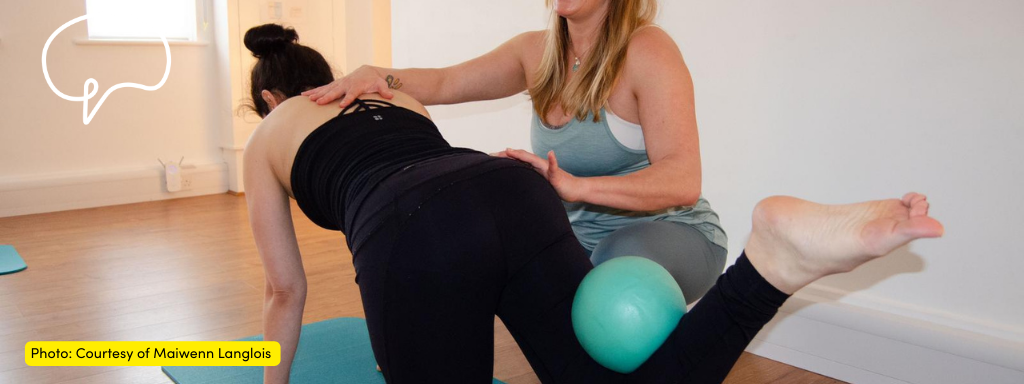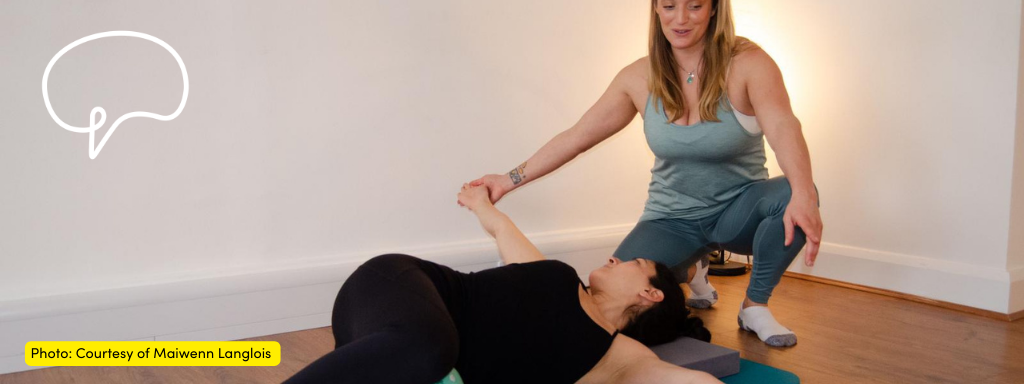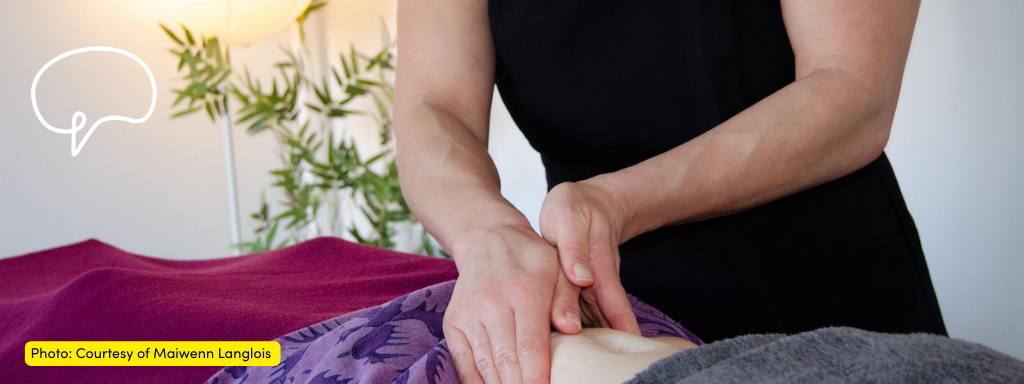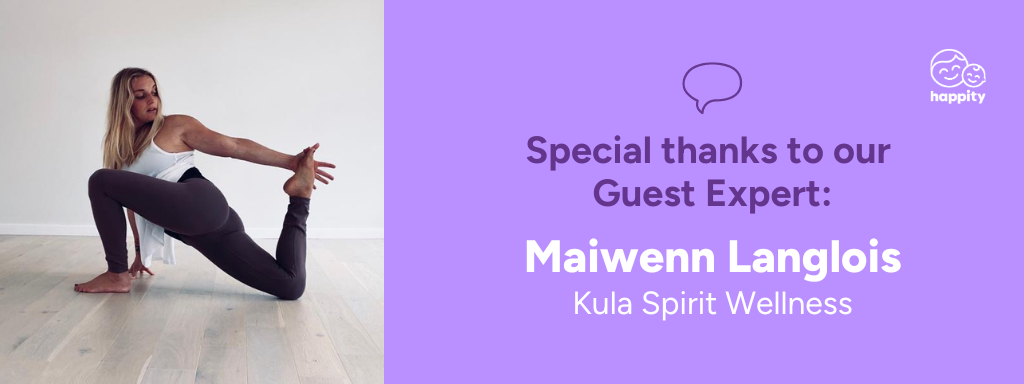We spoke to Pilates and women’s health expert, Maiwenn Langlois of Kula Spirit Wellness, (who specialises in postpartum recovery and abdominal massage) about abdominal separation. We had some time to ask some of the more common questions about abdominal separation and here’s what she said.
Firstly, What is Abdominal Separation?
Abdominal separation is where the muscles of the abdominal wall pull apart during or after pregnancy, leaving a ‘gap’ in the stomach. Its official name is diastasis recti. You should be checked for this during your 6-week appointment. If your gap is less than 2cm, chances are the muscles will start to come back together on their own within 8 weeks – particularly with some careful exercise and lifestyle choices. Postnatal fitness classes are a great place to start.
Anything bigger than 2cm and you will have to do more focused exercises, or will perhaps be referred to a physio or other health-care professional.

How Many Mums At Your Postnatal Pilates Classes Would You Say Have Had A Form Of Abdominal Separation?
I honestly haven’t met one that didn’t. 2cm or below is considered safe. I have never met a woman below 2cm separation 8 weeks after birth.
What Should I Focus on?

Following birth, you need to work on strengthening your core muscles. It’s imperative that we master the basics, particularly when it comes to core strength. Your core stabilises you and mobilises you in every directions, so let’s work it that way.
Can You Recommend Exercises For Abdominal Separation?
Here are a few exercises designed to safely build your obliques, stimulate healthy pelvic floor function, activate transverse abdominals and perfect those posteriors!
1. Leg Slides
Legs slides promote the eccentric engagement of the lower abs and lateral extensors of the spine – basically the muscles that help you walk upright.
- Breath in, maintaining the connection to your centre
- Breathe out as you slide one leg away along the floor in line with your hip, keeping your pelvis and spine stable and in neutral
- Breath into the back of your ribcage as you return the leg to the starting position.
Repeat five times with each leg
2. Knee Drops

Knee drops and opposite arm opening are a great way to access the transverse abdominals (the muscles that suck our tummy in!). You can tie a band around the legs or hold a band in the hands to add resistance.
- Keep the pelvis and torso still and stable, exhale as you draw arm and leg away from the centre line of the body
- Inhale to return with control
3. Baby curl-up (with a small ball behind the back)
Baby curl-ups mobilise the upper thoracic and strengthen neck muscles.
- Place hands behind head softly interlaced. Inhale to prepare.
- Exhale – starting with a nod of the head, pull the ribs down towards the hips and sequentially articulate head, neck and shoulder blades off the floor.
- Stop at the lower ribs. Inhale and hold this position.
- Exhale – with control lower the ribs, shoulder, neck and head back down, extending over the ball.
Try to keep the pelvis still whilst moving into this position.
4. Modified Side Plank

Modified side planks will mobilise the spine and develop shoulder strength and stability whilst activating the obliques.
- Inhale and lift the pelvis and circle the arm overhead
- Exhale as you return the head, chest and arm to the start position on the mat.
Repeat up to five times each side
5. Spine Curls
Spine curls promote sequential mobilisation of the spine and hips, while strengthening the back, abdominals, buttocks and the backs of the legs.
- Breath in and then breath out as you curl your pelvis underneath you, imprinting your lower back into the mat before begin to wheel it off the mat one vertebra at a time
- Breath in and hold this position
- Breath out as you roll the spine back down, softening the breastbone and wheeling once again carefully through each section
- Breath in as you release the pelvis back to neutral position
Repeat up to ten times
If in doubt and any movements feel painful or “heavy down below” contact your fitness professional, GP or pelvic floor specialist.
Any Other Top Tips For Practising Pilates?
Remember consistency is key so developing a daily practice will win the race.
It has taken months, maybe years to get you where you are! So expect results to come in 10-12 weeks as a minimum. Here’s a basic video to help.
And remember – if in doubt and any movements feel painful or “heavy down below”, contact your fitness professional, gp or pelvic floor specialist.
Can I Start Doing Sit-Ups To Help My Abdominal Separation?
No – definitely not! I often get asked why curl-ups are not ideal abs exercises (particularly postpartum).
Although they are great for building the rectus abdominals, they are a big NO-NO when it comes to conditions like abdominal separation, C-section recovery, disc problems and neck pain. They can further pull your body into a forward flexion position and add pressure to the deep core and lower back.
What Do You Enjoy Most About Your Job?
I love that you can physically see the waist draw in after a few weeks with my clients utilising these basic exercises regularly.
Is Abdominal Massage Good For New Mums?

Yes, definitely. Lots of us women share the same common fear – touching or talking about our tummies! But it’s time to change this – by working on the abdomen all of the body systems are addressed: digestion, respiration, nervous, lymphatic , endocrine, urinary, reproductive, skeletal, muscular, emotional and even energetic. You might literally be skipping to the loo afterwards!
Will Abdominal Massage Help If You’ve Had a C-Section?
If you happen to be 1 of the 18 million women per year (20% of all births and counting) that has had a c-section, massage can help to increase scar tissue mobility and elasticity, reduce muscle restriction, reduce numbness. It can also improve sensation around the scar, improve healing process and its appearance as well as reduce pain. It’s time to celebrate your scars!
Thanks to Mai of Kula Spirit Wellness for answering all our questions about abdominal separation and massage.
A Bit About Mai…

Mai is a Pilates instructor and massage therapist, specialising in postnatal issues and abdominal massage.
Here are a few resources that Mai recommends:
- Download this Free Fact Sheet on how to start at home with some stomach massage for constipation, discomfort and bloating relief and endometriosis pain, and to help aid postpartum recovery.
- Visit an abdominal specific masseuse – the full service involves applying gentle pressure, stroking, kneading, and other techniques on the muscles.
Check Out Kula Spirit Wellness Here

Want To Get Out And About, Have Fun With Your Baby Or Toddler, And Meet Other Parents?
Search Happity to find everything that’s happening for the under-5s in your local area – from music and singing classes, to messy play, arts and crafts, baby massage, gymnastics and more. Simply enter your postcode and child’s age to search, and then book your spot in a few taps. Enjoy dedicated fun time with your little one, watch their skills develop, and make friends at the same time. Mums, dads, grandparents and carers will all find something to love!
If You Found This Post Useful, You May Also Like:
5 Mindfulness Activities In Nature For You And Your Family
11 Easy Tips For Getting Your Children Involved In the Kitchen


0 Comments